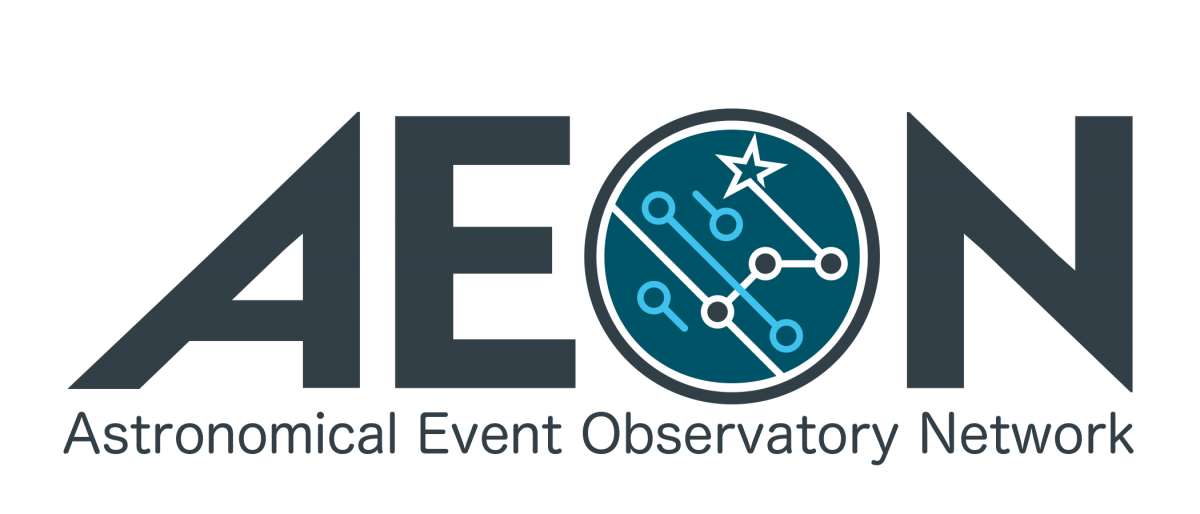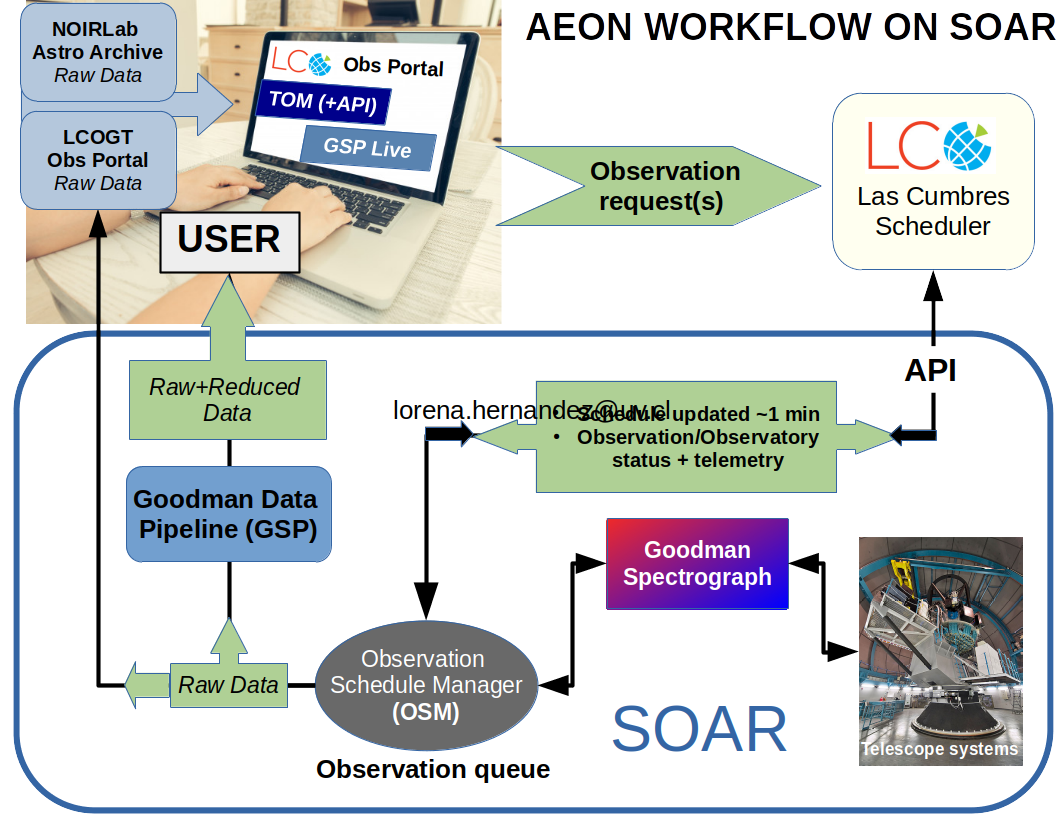AEON on SOAR
The Astronomical Event Observatory Network (AEON) is a facility ecosystem for accessible and efficient follow up of astronomical transients and Time Domain science. At the heart of the network, NOIRLab, with its SOAR 4.1m and Gemini 8m telescopes (and soon the CTIO Blanco 4m), has joined forces with Las Cumbres Observatory to build such a network for the era of the Legacy Survey of Space and Time (LSST). SOAR is the pathfinder facility for incorporating the 4m and 8m class telescopes into AEON.
A recent article on Science magazine features AEON and the windows into Time Domain, Multi-Messenger Astronomy, and general astronomical programs that this project will open up for the astronomical community in the near future. For a quick, simple introduction to AEON, watch the video below.
AEON brings a new observing mode for SOAR: a highly automated observing queue run with minimal human intervention. At present, guide star acquisition, and on-slit acquisition of the science target (for spectroscopic observations), are the only tasks done manually. As has always been the case, Telescope Operators also assess the observing conditions and have the authority and means to start/stop the AEON-queue based on weather or because of technical reasons. Other than these, the AEON-queue on SOAR is created entirely in an unsupervised, automatic way by a scheduler software at Las Cumbres Observatory, which takes all requests submitted by the various program PIs, and sorts them according to a number of parameters, which include (but not limited to) position on the sky, distance to the Moon and airmass constraints, SOAR minimum and maximum elevation limits, time window specified in the observing request.
Current Status:
After successful testing during 2018 and early 2019, SOAR and NOIRLab began offering AEON-SOAR observations, both optical imaging and spectroscopy with the Goodman High Throughput Spectrograph (GHTS), as a regular capability. In 2022B we added the Triple Spec 4.1 near-IR spectrograph to the capabilities supported in AEON mode.
In addition to dynamic, programmatically accessible scheduling, AEON on SOAR provides real-time optical imaging and spectroscopic data reduction, which allows our Goodman spectrograph users to get fully reduced data. The SOAR AEON queue includes an observation of a spectrophotometric standard star every night.
TSpec observations in AEON mode will include a Telluric standard observed immediately after the science target. The Telluric will be picked automatically by the software running the observation, from an extensive list of A0 V stars, with the constraint that the airmass difference be < 0.1. TSpec data are provided in raw form only. Users need to download the IDL-based pipeline to reduce their TSpec observations.
All raw and reduced SOAR data are uploaded to the Las Cumbres data archive, from where users can download their data products.
AEON brings a new observing mode for SOAR: a highly automated observing queue run with minimal human intervention. AEON mode is now being used by programs from most SOAR partners, NOIRLab Open access time, Chile time through the Chilean National TAC, UNC and MSU.
For 2025A we have 29 science programs, 20 regular programs and 9 Target of Opportunity (ToO) programs. We have scheduled AEON for 50 nights.
In 2024B we had 21 science programs, 13 regular programs and 8 Target of Opportunity (ToO) programs, scheduled on 50 nights. In 2024A we had 20 science programs (12 regular and 8 ToOs), scheduled on 42 nights. In 2023B we had 25 science programs (15 regular programs and 10 ToO programs), scheduled on 49 nights (19 programs with Goodman and 6 with TSPec). The actual number of nights each semester ultimately depends on the demand and number of successful programs that request this observing mode.
Proposing for AEON on SOAR
In order to propose for AEON queue-mode observations on SOAR prospective users should go through one of the channels to request time on SOAR, as described in the Proposing for Time on SOAR web page.
For details on instruments and configurations being offered in "AEON mode" on a given semester, and additional information useful for preparing proposals, such as overheads, please refer to the SOAR AEON Features page. Note the addition of TripleSpec 4.1 to the available options.
César Briceño is the AEON Project Scientist for CTIO and SOAR, and SOAR AEON Support Scientist, together with Mark Everett and Konstantine Boutsia.
Observing with AEON on SOAR
|
Astronomers can request observations either through the Las Cumbres Observation Portal, or via standardized, programmable interfaces, using established APIs, supported by the Target Observation Manager (TOM) Toolkit. Users can manage all aspects of their observing programs, including observation requests, by creating an account with the Observation Portal. Once time is awarded, users will find that their active proposals are listed under the 'Manage Proposals' tab and they will be able to request observations. The time needed to execute an observation is debited automatically from the relevant proposal, but only once each observation is completed. If a request cannot be scheduled, no time is debited. |
|
Observations can be requested by filling out the observation request form, or programmatically by submitting a request to our API. We strongly encourage proposers and users to read the "User Guide to AEON programs on SOAR", which describes the AEON observation process on SOAR and provides details on how to submit an observation request to SOAR. Users should also go through the "Las Cumbres Observatory Getting Started Guide", available from their Help page or at this link; it describes the procedure step-by-step. Detailed information on using the APIs can be found at at this link. Be aware that the because the Las Cumbres scheduler uses very conservative estimates for acquisition overheads, the estimated duration of an observation is usually longer than the effective time actually used once the observation is executed. Users will be charged the actual time used, not the initial estimate.
It is important to point that the SOAR AEON queue is an automated system, based on a robotic software scheduler. Therefore neither SOAR or Las Cumbres staff can modify the queue as built dynamically by the scheduler, nor make any tweaks.
Monitoring Your Observing Program
The homepage of a user's Observation Portal will show a list of all of the observations they have requested. Clicking on any observation will display more information on each component of the request, including a wealth of information on its scheduling status, the target visibility, and any data obtained - all updated in real-time. The "Getting Started on the LCO Global Telescope Network" guide in the help page describes the available information in more detail. You can also find information on the status of telescopes in the network.
Data access
As soon as an observation is written to disk at SOAR, the raw Goodman data products are transferred automatically and made available through the Las Cumbres Observatory Archive, and also the NOIRLab Science Archive. Both archives provide the means for users to download the data products.
Goodman optical observations: the SOAR Team has developed a live automated data reduction pipeline for Goodman data. This pipeline runs in real time every AEON night at SOAR, reducing both imaging and spectroscopic data in real time. In addition to the raw data and all calibrations needed to process the data, we also deliver, for imaging, the bias-subtracted, flatfielded images, and for spectra, 1-dimensional, wavelength-calibrated spectra. This is the case for the 400M1 and 400M2 low-resolution setups, our most used configurations. We are working to also produce the wavelength calibration for other configurations. In some cases, such as for extended objects, object crowding or very faint targets, the extraction may fail. In those cases, or when the user wants to coadd their individual reduced spectra, custom processing by the user, with packages such as IRAF or PypeIt may be necessary
TSPec near-IR spectra: for TSpec unfortunately we do not have a real time pipeline like for Goodman. Access to the raw TSPec data is also through the Las Cumbres Observation Portal. You can reduce your TSPec data by downloading and installing the IDL pipeline on your computer. We strongly recommend you watch the step-by-step YouTube videos created by Dr. katelyn Allers, which you can find at this link.
Acknowledging AEON
When publishing your results based on data obtained through the AEON, please include the following text in the acknowledgment section:
Based on observations obtained through the Astronomical Event Observatory Network (AEON), a joint endeavor of the Las Cumbres Observatory and of NSF NOIRLab, which is managed by the Association of Universities for Research in Astronomy (AURA) under a cooperative agreement with the U.S. National Science Foundation.
OR
Based in part on observations ... [the rest as above]
Where to get help
AEON is a collaboration between Las Cumbres Observatory and NOIRLab. The AEON Team gratefully acknowledges funding from the NSF.
Updated on June 5, 2025, 12:45 pm

